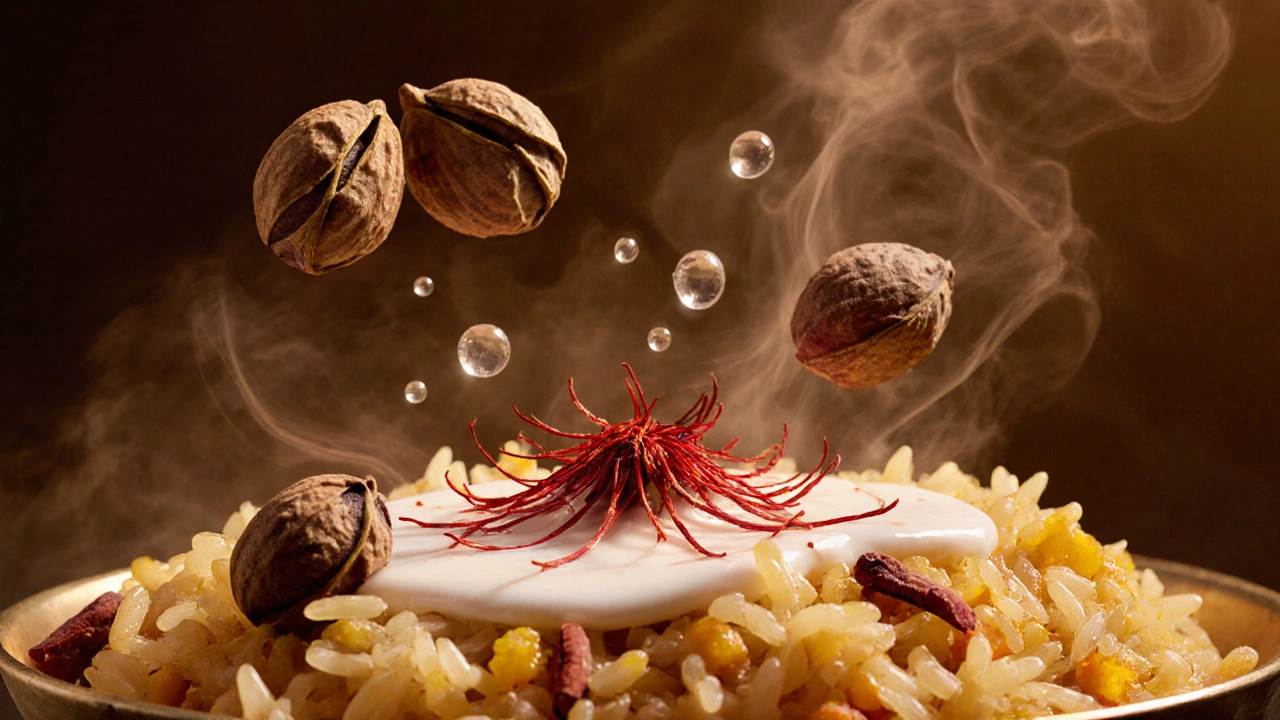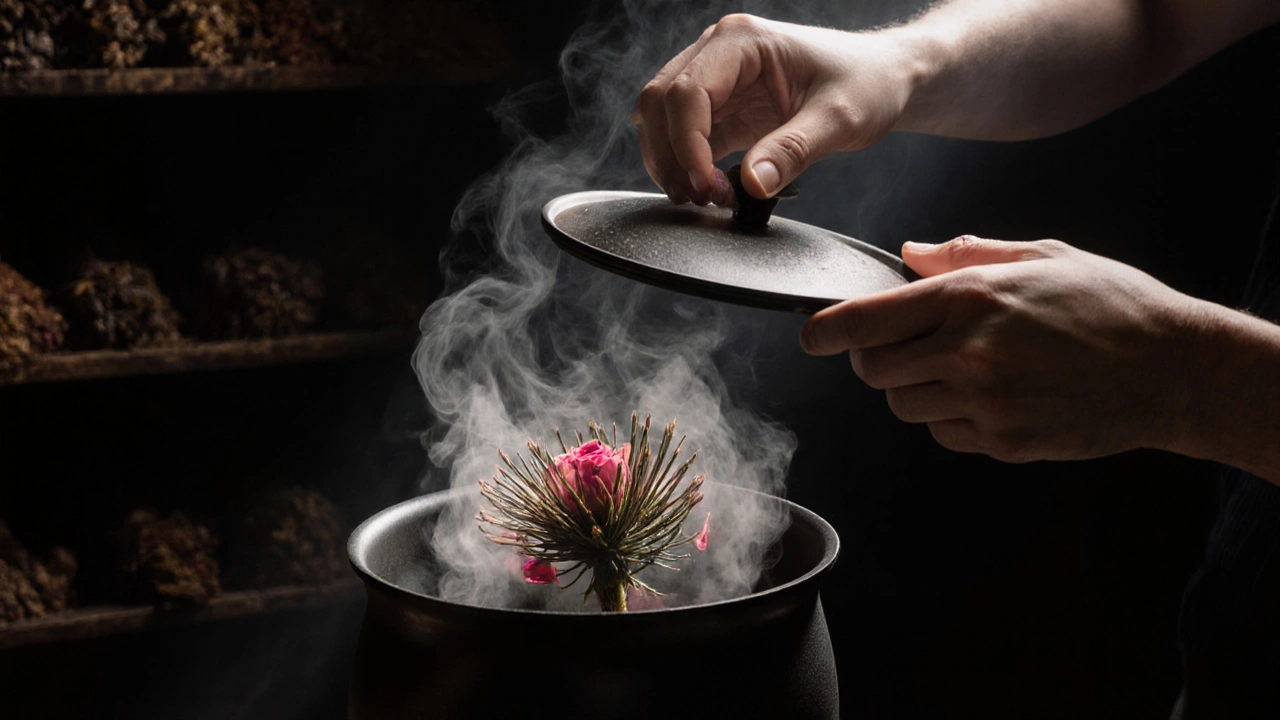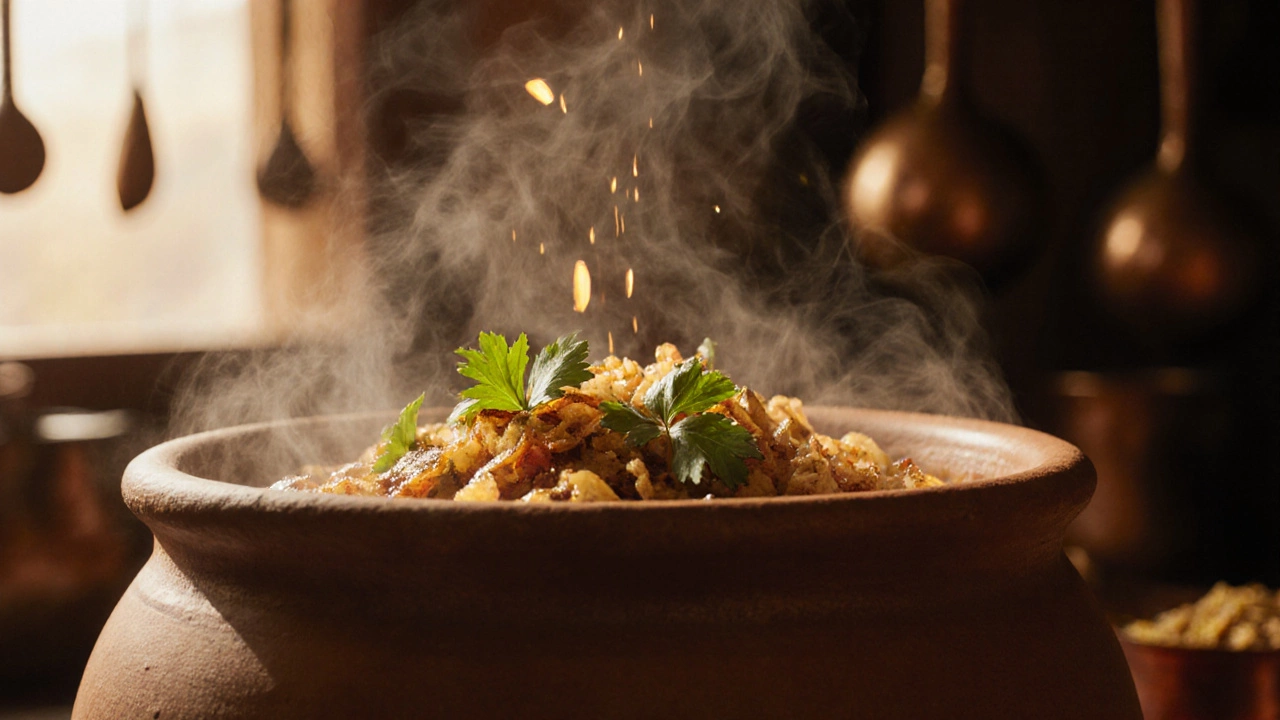Biryani Aroma Checker
Missing Aromas? Check Your Technique
Select which steps you used in your biryani preparation. We'll identify missing components that affect the signature smell.
Results will appear here
The smell of biryani doesn’t just drift from the kitchen-it pulls you in. It’s the kind of scent that makes your stomach growl before you even see the plate. People talk about the secret smell of biryani like it’s magic. But there’s nothing mystical about it. It’s chemistry, timing, and a handful of ingredients most home cooks overlook.
The Layers That Build the Smell
Biryani isn’t one smell. It’s a stack of them. First, there’s the sizzle of onions frying in ghee until they turn golden brown. That’s the base. Then come the whole spices: cardamom pods cracking open, cinnamon sticks releasing their sweet warmth, cloves popping like tiny fireworks. These aren’t just added to the pot-they’re toasted in oil first. That’s step one most recipes skip.
Next, the garlic and ginger paste hits the pan. It doesn’t just cook-it caramelizes. That’s when the sharp bite turns deep and earthy. Then the meat or vegetables go in. If you’re using chicken, it’s browned hard on the outside. That Maillard reaction? That’s where the umami starts. Lamb? It’s seared until the fat begins to render. That’s the smell that lingers on your clothes hours later.
The Hidden Spices You’re Not Using
Most people think biryani is just turmeric, cumin, and coriander. But the real magic comes from the ones you don’t see. Saffron soaked in warm milk isn’t just for color. It’s the thread that ties the whole aroma together. A few strands, steeped for 15 minutes, release a floral, honey-like note that cuts through the richness.
Then there’s kewra water. It’s not common in every kitchen, but if you’ve ever smelled it, you’ll know why. It’s distilled from the screwpine flower. It smells like tropical flowers mixed with vanilla and a hint of citrus. Just two drops stirred into the rice at the end-no more-turns the steam into something unforgettable. You won’t find it in grocery stores unless you go to an Indian or Pakistani specialty shop. But once you use it, you won’t make biryani without it again.
And don’t forget rose water. Not the kind you use on your face. The culinary grade, sold in small bottles with a dropper. A single drop mixed into the yogurt marinade adds a quiet sweetness that balances the heat. It’s subtle, but it’s the reason your biryani smells like a garden after rain, not just a spice rack.
The Rice Is the Silent Star
The rice doesn’t just soak up flavor-it becomes part of the scent. Basmati rice from the foothills of the Himalayas is the only kind that works. It’s long, thin, and smells like popcorn when dry. But that’s not enough. You have to soak it for 30 minutes before cooking. That’s not optional. It lets the grains swell just right so they don’t break when layered with meat.
Then comes the water. Not plain. Salted. With a whole star anise and a bay leaf tossed in. Some cooks add a splash of lemon juice. Others throw in a few mint leaves. The rice steams in this scented water, absorbing every bit of it. When you drain it, the grains aren’t just cooked-they’re perfumed.

Dum Cooking: The Slow Secret
Here’s where most home cooks mess up. They rush. They open the pot too early. But biryani’s real smell comes from dum cooking-sealed in a heavy pot with dough around the lid. The steam has nowhere to go. It circles, condenses, and falls back into the rice and meat, carrying the aromas deeper with every minute.
Traditionally, the pot is placed over a low flame for 20 to 30 minutes. Some use a charcoal fire underneath for extra smokiness. That’s where the real depth comes from-not just the spices, but the slow, trapped heat. The meat becomes tender, the rice becomes fragrant, and the whole thing turns into one scent that clings to the air.
The Final Touch: Fried Onions and Fresh Herbs
Right before serving, you sprinkle fried onions. Not the kind from a bag. You slice them thin, fry them slowly in ghee until they turn dark brown and crispy. That’s the crunch, yes-but also the smell. Caramelized sugar, burnt edges, oil that’s been kissed by spice. It’s the final layer.
And then the herbs. Fresh coriander leaves, chopped fine. Mint, if you’ve got it. A few sprigs tossed on top just before serving. They don’t cook. They release their oils into the steam rising off the dish. That’s the bright, green note that keeps the whole thing from feeling heavy.

Why Your Biryani Doesn’t Smell Like That
If your biryani smells flat, it’s probably because you’re adding everything at once. Spices don’t bloom in water. They need heat and oil. You can’t just dump ground cumin into the pot and expect magic. Toast them. Bloom them. Let them sing before you add anything else.
Also, skipping the marination. Yogurt, lemon, ginger-garlic paste, and a pinch of turmeric-left on the meat for at least 4 hours, overnight if you can. That’s not just for tenderness. That’s when the spices start to penetrate, and the smell begins to build from the inside out.
And don’t use old spices. If your cardamom pods look dull, or your cinnamon smells like dust, toss them. Freshness isn’t a suggestion-it’s the rule. A spice that’s been sitting for two years won’t give you the smell you’re chasing.
How to Test If You Got It Right
When the pot is opened, the steam should hit you first. Not just hot, but fragrant. You should smell the saffron, the kewra, the fried onions, and the herbs all at once-not one after the other. If you can close your eyes and picture the field where the saffron was harvested, or the market stall where the kewra was distilled, you’ve done it right.
The smell should follow you into the next room. It should linger on the spoon when you stir it. It should make someone walk in from another house and ask, ‘What’s cooking?’
That’s not luck. That’s technique.
What to Do If Your Biryani Smells Off
If it smells burnt, you cooked the bottom too fast. Next time, use a heat diffuser or put the pot on a trivet. If it smells too spicy, you used too much chili powder or didn’t balance it with yogurt or rose water. If it smells bland, your spices are old or you didn’t toast them. And if it smells like plain rice with meat? You skipped the layers.
There’s no shortcut. The smell of biryani is built, not added. It’s the result of patience, attention, and respect for each step.
Why does my biryani smell like plain rice even after adding spices?
You likely added the spices directly to the rice or meat without blooming them first. Spices need heat and oil to release their oils and aromas. Toast whole spices in ghee before adding anything else. Ground spices should be fried for 30 seconds in hot oil. Skipping this step means the flavors stay locked inside the spice particles.
Can I use store-bought biryani masala instead of whole spices?
You can, but you’ll miss the depth. Pre-made masalas are convenient, but they often contain fillers like salt, flour, or artificial flavors. They’re designed for quick cooking, not layered aroma. If you use them, still toast them in oil and add kewra water, saffron, and fried onions separately to rebuild the missing layers.
What’s the difference between kewra water and rose water in biryani?
Kewra water comes from the screwpine flower and has a tropical, almost perfumed sweetness with citrusy notes. Rose water is floral and fruity, more like a garden. Kewra is stronger and used in smaller amounts-just two drops. Rose water is gentler and works well in the marinade. Using both together creates a complex, layered fragrance that’s hard to replicate.
Is basmati rice the only rice I can use for biryani?
Technically, no-but everything else will fail. Long-grain rice like jasmine or sushi rice breaks down too easily. Short-grain rice becomes mushy. Basmati has a natural aroma, elongates when cooked, and stays separate. It’s the only rice that carries fragrance without turning sticky. If you can’t find authentic Himalayan basmati, look for aged basmati labeled ‘extra long grain.’
Why does the smell disappear when I reheat biryani?
The volatile oils in saffron, kewra, and fresh herbs evaporate quickly. Reheating in the microwave destroys them. To preserve the smell, reheat biryani gently in a covered pot on low heat with a splash of water. Sprinkle a few drops of kewra water and fresh herbs on top just before serving. That’s how restaurants keep the aroma alive.

